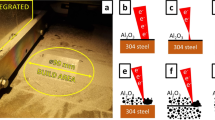Abstract
Selective laser sintering (SLS) is a rapidly developing additive manufacturing technique, with advantages in flexibility and low material waste. Many parameters used in a SLS process are determined by powder type: blended powders have limitations due to wetting and diffusion, while prealloyed powders require processing in a small temperature range dictated by the alloy composition. As an alternative to these, a coated powder was fabricated by electrochemical means. This tin–copper composite powder was compared with a blend of tin and copper powders, using metallographic, crystallographic, and thermal analysis techniques as well as SLS. It was found that, because of the uniform distribution of liquid and increased contact between phases in the composite powder, sintering took place in the composite powder but not in the blend. After a homogenization treatment, mechanical testing of the sintered samples showed that the strength and ductility were comparable to high-porosity materials produced using other techniques.











Similar content being viewed by others
References
J.P. Kruth, G. Levy, F. Klocke, and T.H.C. Childs: Consolidation phenomena in laser and powder-bed based layered manufacturing. CIRP Ann.-Manuf. Technol. 56(2), 730 (2007).
D. Gu and Y. Shen: Balling phenomena in direct laser sintering of stainless steel powder: Metallurgical mechanisms and control methods. Mater. Des. 30(8), 2903 (2009).
A.T. Hasouna, K. Nogi, and K. Ogino: Effects of temperature and atmosphere on the wettability of solid copper by liquid tin. Trans. Jpn. Inst. Met. 29(9), 748 (1988).
D. Gu and Y. Shen: Effects of dispersion technique and component ratio on densification and microstructure of multi-component Cu-based metal powder in direct laser sintering. J. Mater. Process. Technol. 182(1–3), 564 (2007).
J.P. Kruth, B. Van der Schueren, J.E. Bonse, and B. Morren: Basic powder metallurgical aspects in selective metal powder sintering. CIRP Ann.-Manuf. Technol. 45(1), 183 (1996).
Y.P. Kathuria: Microstructuring by selective laser sintering of metallic powder. Surf. Coat. Technol. 116–119(0), 643 (1999).
M. Agarwala, D. Bourell, J. Beaman, H. Marcus, and J. Barlow: Direct selective laser sintering of metals. Rapid Prototyping J. 1(1), 26 (1995).
F. Klocke and C. Wagner: Coalescence behaviour of two metallic particles as base mechanism of selective laser sintering. CIRP Ann.-Manuf. Technol. 52(1), 177 (2003).
N. Saunders and A.P. Miodownik: The Cu-Sn (copper-tin) system. Bull. Alloy Phase Diagrams 11(3), 278 (1990).
J.W. Price: Tin and Tin Alloy Plating (Electrochemical Publications Limited, Ayr, Scotland, 1983).
R.M. German: Powder Metallurgy & Particulate Materials Processing (Metal Powder Industries Federation, Princeton, NJ, 2005).
R.M. German: Particle Packing Characteristics (Metal Powder Industries Federation, Princeton, NJ, 1989).
Y. Fujiwara and H. Enomoto: Intermetallic phase formation in electrochemical alloy deposition. J. Solid State Electrochem. 8(3), 167 (2004).
W. Zhai, W.L. Wang, D.L. Geng, and B. Wei: A DSC analysis of thermodynamic properties and solidification characteristics for binary Cu–Sn alloys. Acta Mater. 60(19), 6518 (2012).
S. Fürtauer, D. Li, D. Cupid, and H. Flandorfer: The Cu–Sn phase diagram, Part I: New experimental results. Intermetallics 34(0), 142 (2013).
Z. Mei, A.J. Sunwoo, and J.W. Morris: Analysis of low-temperature intermetallic growth in copper-tin diffusion couples. Metall. Trans. A 23(3), 857 (1992).
I. Tuah-Poku, M. Dollar, and T.B. Massalski: A study of the transient liquid phase bonding process applied to a Ag/Cu/Ag sandwich joint. Metall. Trans. A 19(3), 675 (1988).
Y. Zhou: Analytical modeling of isothermal solidification during transient liquid phase (TLP) bonding. J. Mater. Sci. Lett. 20(9), 841 (2001).
N.F. Kennon and J.S. Bowles: The crystallography of the B.C.C. to orthorhombic γ′1 martensite transformation in copper-tin alloys. Acta Metall. 17(4), 373 (1969).
N. Saunders and A.P. Miodownik: Phase formation in co-deposited metallic alloy thin films. J. Mater. Sci. 22(2), 629 (1987).
E.M. Castrodeza and C. Mapelli: Processing of brass open-cell foam by silica-gel beads replication. J. Mater. Process. Technol. 209(11), 4958 (2009).
D.A. Ramirez, L.E. Murr, S.J. Li, Y.X. Tian, E. Martinez, J.L. Martinez, B.I. Machado, S.M. Gaytan, F. Medina, and R.B. Wicker: Open-cellular copper structures fabricated by additive manufacturing using electron beam melting. Mater. Sci. Eng., A 528(16–17), 5379 (2011).
M. Shehata Aly, A. Almajid, S. Nakano, and S. Ochiai: Fracture of open cell copper foams under tension. Mater. Sci. Eng., A 519(1–2), 211 (2009).
A.M. Parvanian and M. Panjepour: Mechanical behavior improvement of open-pore copper foams synthesized through space holder technique. Mater. Des. 49(0), 834 (2013).
ACKNOWLEDGMENTS
The authors would like to thank Mr. Rosen Ivanov and Mr. Petr Fiurasek for their assistance in the experiments, and McGill University for providing funding through the McGill Engineering Doctoral Award.
Author information
Authors and Affiliations
Corresponding author
Rights and permissions
About this article
Cite this article
Walker, D.C., Caley, W.F. & Brochu, M. Selective laser sintering of composite copper–tin powders. Journal of Materials Research 29, 1997–2005 (2014). https://doi.org/10.1557/jmr.2014.194
Received:
Accepted:
Published:
Issue Date:
DOI: https://doi.org/10.1557/jmr.2014.194




